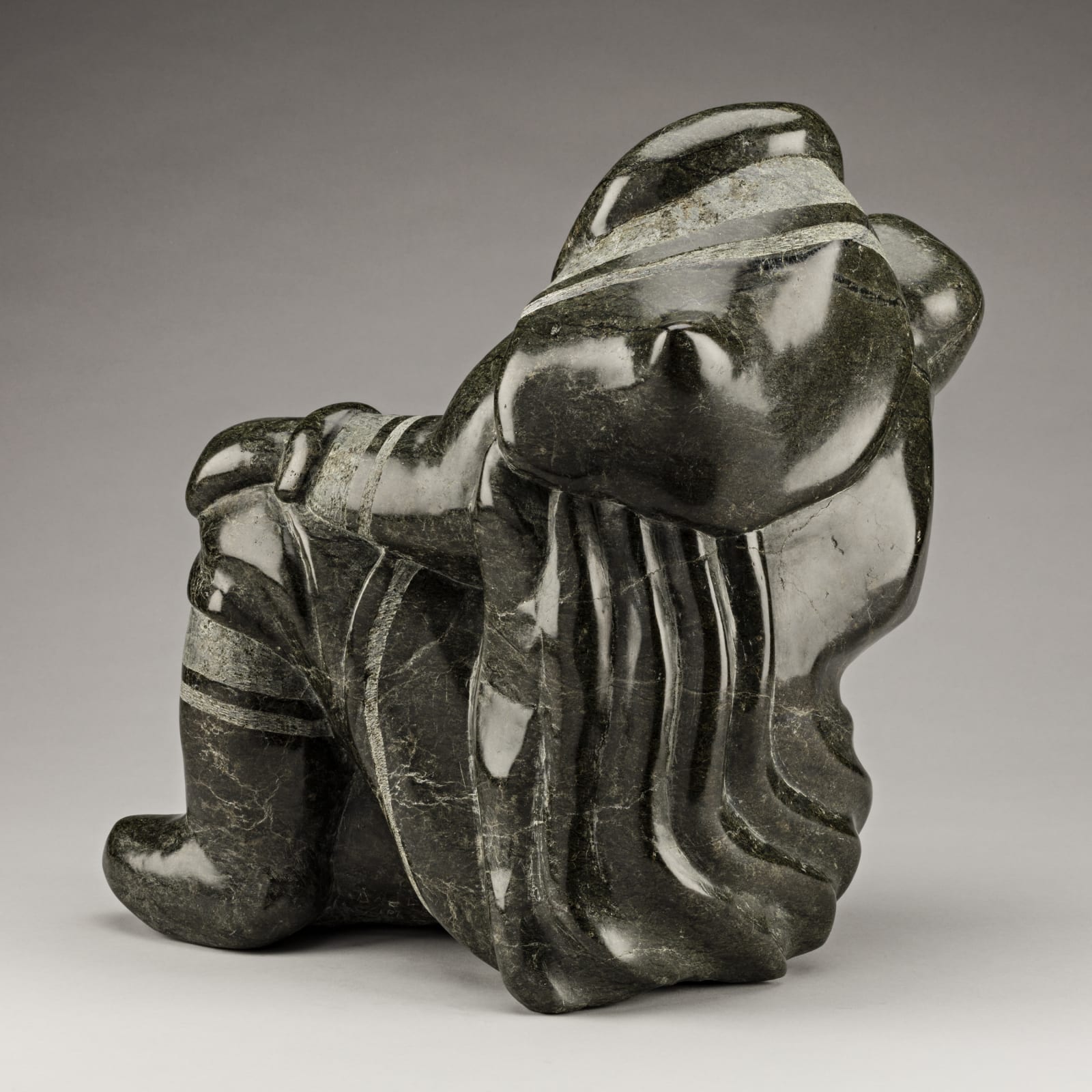OSUITOK IPEELEE, R.C.A. (1922 or 1923-2005) KINNGAIT (CAPE DORSET
stone, 16 x 12 x 14 in (40.6 x 30.5 x 35.6 cm)
Osuitok was born at Neeouleeutalik camp near southern Baffin Island and lived a traditional hunting life for decades. He first began carving at age 13 making toys out of wood. While still in his twenties he learned to carve ivory. It was only in the early 1950s that Osuitok began to sculpt in stone, encouraged by James Houston. Osuitok went on to become arguably the greatest Inuit sculptor of all time. His work is included in virtually every major public, private and corporate collection of Inuit art.
In his foreword to the catalogue for the 1980 exhibition Cape Dorset at the Winnipeg Art Gallery, James Houston writes of his first meeting with the artist in 1951, “Oshaweetok B had been spoken of by all Inuit as being the most famous carver on that coast. Naturally I could scarcely wait to meet him” [1]. Houston goes on to relate that he had visited the artist’s home, “Oshaweetok and his kindly wife Nepeesha had the neatest, most impressive igloo I had ever seen... Animal and bird drawings from Dewey Soper’s books had been carefully removed and pasted to the low ceiling so that one could lie in the Osuitok family’s bed and carefully study them” [2]. Both James and Alma Houston remarked at the hospitality of Osuitok and his wife Nipisha [3].
Women — specifically depictions of mothers and children - have long been appreciated as being emblematic of the communitarian aspect of Inuit culture. Portrayals of women have proved to be an inexhaustible theme for Osuitok. In her essay on the artist in Inuit Art: An Anthology (1988), Jean Blodgett writes: “He [Osuitok] pays tribute to the Inuit woman’s ability to fish, sew and care for children, and he frankly admires their physical form” [4].
Mother with Owl and Seal Children demonstrates Osuitok’s fascination with female subjects and his mastery of the stone (in this case the rather obdurate stone quarried at Markham Bay), where refinement is developed to the artist’s characteristically high degree. Mother with Owl and Seal Children also illustrates his inventiveness and even his sense of humour. Osuitok’s revisiting of a central motif across his lengthy and celebrated career allowed the artist to explore a multitude of permutations and nuances of his figures’ body languages. In this fine example the young woman’s round facial features are immediately appealing. Her form is convincingly resolved: the entirety of this rather sizable stone has been finely worked and we, the viewers, are drawn to move around the carving to fully appreciate it from all angles.
At the back, her amautiq transforms into billowing drapery that recalls the deep folds of the fabric garment that Osuitok created in 1959 for his portrait of Queen Elizabeth II. However, as might be expected with the passage of time and the honing of a skill and imagination, in the present Mother with Owl and Seal Children we see considerable whimsy in the depiction of the woman’s clothes. Perhaps the owl child is sending her mother’s amautiq tail aflutter!
Osuitok is as famous for his quirky depictions of owls as he is for his serene portrayal of women. In an uncited interview from her article on Osuitok for Inuit Art: An Anthology, Jean Blodgett repeats the following quotation from the artist on the two subjects that were a particular focus in his career, “‘...in different years mostly birds or mostly humans, and so on’” [5]. Here Osuitok combines two favourite and quintessential subjects with great success and aplomb into one rather monumental image — that becomes an even more surprising one when we realize that the body of the owl-child transforms into that of a beautifully sensitive seal. The artist transforms what might have been a fairly straightforward depiction of a mother and child into a striking and enigmatic image of a goddess-like woman and her animal children. Mother with Owl and Seal Children is quite likely unique in Osuitok’s body of work.
-
1. Cape Dorset, (Winnipeg, MB: Winnipeg Art Gallery, 1980), p. 9
2. Ibid., p. 10
3. Ibid., p. 10 & 15
4. Jean Blodgett, "Osuitok Ipeelee", Inuit Art: An Anthology, (Winnipeg, MB: Watson & Dwyer, 1988), p. 46
5. Ibid., p. 45
Provenance
Susan & Eliot Black, Scottsdale, AZ.Join our mailing list
* denotes required fields
We will process the personal data you have supplied in accordance with our privacy policy (available on request). You can unsubscribe or change your preferences at any time by clicking the link in our emails.




